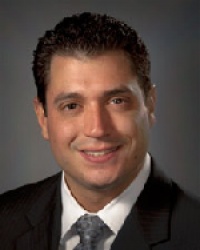Dr. Donald W. Alves, MD
Emergency Physician
10 N Greene St Emergency Department Baltimore MD, 21201About
Dr. Donald Alves practices Emergency Medicine in , MD. Dr. Alves assesses patients who seek immediate medical attention at any time of day or night. Emergency Medicine Physicians are trained to efficiently work with each patient and situation no matter how acute or life-threatening. Dr. Alves examines patients, determines means of testing, diagnoses conditions, and decides the best treatment methods.
Education and Training
Eastern Virginia Medical School
Eastern Virginia Medical School 1997
Board Certification
American Board of Emergency Medicine
Emergency MedicineAmerican Board of Emergency MedicineABEM
Provider Details
Dr. Donald W. Alves, MD's Expert Contributions
What are the symptoms of food poisoning?
Possibly. Some food allergies or sensitivities may induce a "rapid exit" phenomenon, e.g., diarrhea and abdominal discomfort while being eliminated ASAP. Food poisoning depends on the organism or toxin involved and often is identified earlier in the GI process, so presents with vomiting and abdominal discomfort -- seeking to eliminate the offending substance before it gets further along the GI tract. If it presents later, then can see the abdominal distress and diarrhea. If worried, consult your primary care provider or an Urgent Care Center. Donald W. Alves, MD,MS,FACEP READ MORE
My child has panic attacks. What should I do?
You need to speak frankly with the child's pediatrician. There can be multiple origins to the situational/stress reaction that culminates in what is referred to as a "panic attack." Dietary issues, social stressors (school/home/other), learning or psychological conditions, among other potential diagnoses--and as different as they sound, as are the interventions and treatments that can help manage and reduce their occurrence. For the short term, when one comes on, calming tones and reassuring brief phrases while attempting to limit external stimulation (bright light/noises/movement in the area, all of which are found in excess in an Emergency Department) can help the child gain a foothold to attempt to self-soothe/de-effervesce and regain their sense of control. Focus on slow and steady breathing. Eyes closed usually helps, and ear muffs (compact and comfortable - -not for the firing range, but to help reduce environmental noise). Donald W. Alves, MD,MS,FACEP READ MORE
When should I be worried about a fever in my child?
If you would like to be absolutely certain that your child catches something, by all means, take her to an ER. Otherwise, stop and ask these questions: 1) what have I done about it? Did you give age/weight appropriate dose of Children's Tylenol or Advil? You would be miserable with a temp of 102F as well. Try to fix that with simple intervention of medication. Next, is the child eating/drinking like usual or close to it? If no, do need to go to ER. If yes, keep reading. Is child -- once the fever down -- his or her usual self? If they are alert, engage with family, interact like usual, it is generally OK. If a child sleeps more when sick, it is because they are smarter than we are, and do not want to be awake to 'enjoy' every minute of the illness. Sleep facilitates recovery, as long as appropriate when awake. If lethargic, sleepy, poor feeder or won't eat or drink -- time to go to the ER. Last, fever is a matter of degree -- pun intended. If generally healthy, 102 is not that bad. 104 is not great. Either should be given a dose of medicine to lower the fever and see how it is going in about 1/2 hour. If child has medical issues, seizure disorder, asthma, etc., then you should discuss this in advance with your pediatrician. Donald W. Alves, MD, MS, FACEP READ MORE
Should I go to the ER for a UTI?
Are you sure it is a "duck?" While the ER should just about never be the place to go if you have other access options and are comfortable that your issue is a urinary tract infection (UTI) -- in your example, those are almost never accompanied by severe abdominal pain. So, I would suggest that you have severe abdominal pain, which only rarely can be properly evaluated in office or clinic settings and should go to the ER. Appendicitis; torsion; diverticulitis; gallbladder issues; early pregnancy issues; and multiple others can cause the symptom. While it is true that drinking water will not temporize the pain from the concerning potential actors above, relying on a coincidence can often delay presenting for evaluation and care. Get seen and feel better. Donald W. Alves, MD, MS, FACEP READ MORE
Should I be concerned about the Tide Pod challenge?
In a word, YES. Household chemicals are not intended for human consumption, and modern cleaning agents have a much greater potential for harm than an old-fashioned bar of soap. You should speak with those under your care about the dangers of peer pressure, and the concept that it being "in print" or "on the Internet" does not have any bearing on factual accuracy or truth. Individual medical conditions, sensitivities, and prescribed medication use can all interact to make an individual more susceptible to a bad outcome, and, especially in the young, can result in a lifetime of difficulties and disability. Cinnamon, Tide pods, bath salts - all have appropriate uses, and inappropriate suggestions for alternate intake, masquerading as a "challenge" or similar term, posted or reposted by persons not interested in your personal health or safety. Donald W. Alves, MD,MS,FACEP READ MORE
Can stroke be identified early in a person?
That is a multi-faceted question, depending on how early and how definitively. Many persons who go on to have a stroke have warning symptoms in the hours to days prior--transient impairments (often called TIAs) that resolve after a few minutes. If these brief episodes of one-sided weakness / facial appearance change, or speech changes are mis-attributed by the patient to an unlikely medical cause, then they cannot aid the patient by getting them in to care earlier--and before the onset of a stroke. As to once the blood vessel is blocked, symptoms come on immediately as the brain does not tolerate lack of blood flow to deliver its nutrients and oxygen. If, alternatively, the vessel leaks, those symptoms intensify over time, usually starting with an intense/sudden/severe headache, and symptoms can further develop or progress as the bleeding into the closed-space of the skull continues, depending upon where the event is taking place. If in doubt, call 911. Time is brain. Donald W. Alves, MD, MS, FACEP READ MORE
How can we revive a person who passes out?
You should strongly consider calling 911 if someone "passes out" and there is any suspicion that something other than alcohol (alone) is the cause--other drugs, diabetes, trauma, infection, etc. If someone drinks enough alcohol to cause them to lose consciousness, it is concerning as they may still be absorbing alcohol from what they drank, which may increase their alcohol level even higher, and become a threat to their life. There is no method to "un-drunk a drunk" other than time. The wives' tale about coffee might make them a TINY bit more alert, but still very intoxicated, and not likely able to help care for themselves or move safely without fall risk, etc. Same goes for other stimulant drugs/energy drinks/etc. Best option is to place the person on his/her side, with lower arm extended upward and head resting on it, and legs spread to increase balance and stability of staying in that position. This can be done up against a piece of furniture or wall to provide extra support. That way, if they should vomit, it will drain out, and not cause them to choke. Donald W. Alves, MD, MS, FACEP READ MORE
What is the treatment for anaphylaxis?
Severe allergic reactions often worsen in intensity and speed of progression with repeat exposure. Ideally, your son's EpiPen (or equivalent) should be readily available to where he is at all times, especially for outdoor activities. An age/weight appropriate dose of Benadryl should be kept with the pen (ask your prescriber to confirm the dose). As soon as sting identified to have occurred, with his history, give the Benadryl and administer the EpiPen, then call 911. If you know how, remove the stinger (for bees). Sit the patient in an easily accessible location for when EMS arrives, and attempt to keep him calm. Other than the Benadryl (and sip of drink to swallow it with), give nothing by mouth. If EMS is delayed, or symptoms progress despite the above, if the particular epinephrine autoinjector has a second dose, prepare the unit to administer it (usually twist-n-lock), and give second dose as advised by your prescriber. Donald W. Alves, MD,MS,FACEP READ MORE
How should I prevent heat strokes?
Adequate hydration is the primary prevention for heat illness. Other factors include access to adequate shade and other cooling factors (breeze, fan, ice, etc.), work or activity breaks to prevent over-exertion, and ideally a mechanism to unload accumulated heat burden over the day--cool shower, pool, misting station, etc. Review any medications for their impact on temperature control. Be particularly careful with the young, the old, the debilitated, and the obese. General benefit is also seen with sunscreens/hats or other protection for the skin directly. Donald W. Alves, MD, MS, FACEP READ MORE
What should be done in case of a person feels frozen?
If the individual is alert enough to feel this way, they may safely sit by a fire or heater or under an electric blanket and self-monitor for getting too warm--they need external heat applied, after outer and wet items removed. If the person is confused, intoxicated, frail/elderly or otherwise should not be relied upon to control their own rewarming and heat exposure, then someone must remain with them constantly to avoid thermal injury (/burn) while trying to rewarm from cold exposure. If awake and alert, warm liquids (cocoa, tea, broth, etc.) can be given as well. If they are mentally altered, then EMS should be contacted while starting initial warming as possible. Donald W. Alves, MD, MS, FACEP READ MORE
I'm curious. What are some of the most common reasons people need an emergency medicine doctor for?
The most common reason people go to the ER relates to pain. Abdominal pain most often, but chest/back/muscle/joint -- with or without a history of injury or trauma -- to be evaluated and determined how to address. We see all comers for all reasons: orthopedic injuries, wounds, breathing difficulties, drug/alcohol use problems, social issues like abuse or loss of medical access to care, psychological issues. Whatever it is, we either treat it, or consult a specialist to address the issue. Donald W. Alves, MD,MS,FACEP READ MORE
How are 2nd and 3rd burns treated?
Third degree burns have destroyed the full-thickness of the skin, so unless very small in size, require skin grafting to heal properly. Grafting can be done by several specialties in medicine, but most often Plastic Surgeons. Second degree burns are partial-thickness, and their care ranges from supportive (topical agents to minimize scar, keep skin healthy, prevent or treat infection) to interventions like with full thickness, depending on if they are superficial-partial-thickness or deep-partial-thickness, their location on the body, and their size. Donald W. Alves, MD,MS,FACEP READ MORE
What are the symptoms of a staph infection?
Symptoms of staph infection vary by location (lungs, bladder, skin), but in general for skin infections with staph should expect to see redness, increased warmth, and usually tenderness of the area. Staph often is associated with abscess formation, so may see local area of swelling / bulging tissue, that may feel fluctuant (a bit like a water balloon). If the infection spreads, can develop fevers, chills, sweats. In general, should start off by seeing your Primary Care Provider or an Urgent Care for small or early skin infections. The Emergency Department only if see red marks moving up a limb from the original infection location ("streaking"), involves about 1/4 or more of the limb--much earlier if diabetic, elderly, immunocompromised, have indwelling hardware / grafts / shunts, or other complicated medical patients. Donald W. Alves, MD, MS, FACEP READ MORE
What are the immediate steps to do for a heart attack?
The most important first step as a patient or concerned person nearby to someone who may be having a heart attack is to RECOGNIZE IT. About 2/3 of persons, males more than females, present in a pattern that could be considered "typical" or "classic"--this would be chest heaviness or uncomfortable pressure, often with radiation of the pain to the neck or arm (left more often than right), and often associated with an increased work of breathing, sweating, and nausea. The elderly, diabetics, and females more often have variants, some with little to no pain in the chest but with the radiating pain, some get acutely confused, some feel profoundly weak, and the difficulty breathing, sweating and nausea are usually present. Unfortunately, for 300-500K Americans per year, the first sign is cardiac arrest--so if concerned, better to call 911 and have an EMS professional start assessing you and transport you to an Emergency Department. You should NOT try to drive yourself to the Emergency Department if you think you are having a heart attack--this is the time to call 911. If your Primary Care Provider has counseled you to use aspirin for heart attack prevention, then you may consider taking four "baby" aspirin (4x81mg=324mg) or one regular strength aspirin (325mg)--but these should be chewed if taken--if uncertain, wait for EMS, as they may give it to you, or the Emergency Department will. Donald W. Alves, MD, MS, FACEP READ MORE
What should be done when one's sodium levels suddenly drop?
Hyponatremia, or a significant drop in sodium level, is not a do-it-yourself repair. It is life-threatening, causing confusion, seizures, heart rhythm problems, and potentially death. The treatment depends on how quickly the sodium level dropped. Advanced age, kidney disease, infection of the urinary tract with certain bacteria, and some medications increase the risk of occurrence. A diet with liberalized (but not high) salt intake, and monitoring fluid intake to be certain that excess water is not ingested, can help reduce the risk of recurrence. READ MORE
Is blood pressure levels of 210/100 an emergency?
No, not if she is asymptomatic, however, it does need treatment urgently by her primary care doctor. Donald W. Alves, MD, MS, FACEP READ MORE
low low grade fever
Unfortunately, this is not enough information for a definitive answer. Fever does not usually go with peptic ulcer, unless it is eroding through and leaking into the abdomen, which then usually causes significant illness and/or discomfort, prompting an ER visit for care. If unrelated, the low-grade/intermittent fevers may be from an early viral process that is common this time of year - -the actual flu (influenza), or one of a few viral infections that cause either upper respiratory illness or GI tract illnesses. The flu and upper respiratory infections often last for a week. See your doctor or an Urgent Care if new symptoms or if worsening condition. Donald W. Alves, MD, MS, FACEP READ MORE
Expert Publications
Data provided by the National Library of Medicine- The demographics of e-mail for emergency medicine research.
- Ambulance snatching: how vulnerable are we?
- Effect of lunar cycle on temporal variation in cardiopulmonary arrest in seven emergency departments during 11 years.
- Community-acquired pneumonia in casualty: etiology, clinical features, diagnosis, and management (or a look at the "new" in pneumonia since 2002).
- Bacterial pathogens in ambulances: results of unannounced sample collection.
- A public health enforcement initiative to combat underage drinking using Emergency Medical Services call data.
- Methicillin-resistant staphylococcus aureus nasal colonization prevalence among Emergency Medical Services personnel.
- Clinical encounters in tactical medicine: a mission-specific analysis of the Maryland State Police experience.
Dr. Donald W. Alves, MD's Practice location
Pikesville, MD 21208Get Direction
Dr. Donald Alves
10 N Greene St Emergency Department -Baltimore, MD 21201Get Direction
Dr. Donald W. Alves, MD's reviews
Write ReviewRecommended Articles
- What Is Cat Scratch Fever?
IntroductionCat scratch fever or cat scratch disease is a bacterial infection spread by cats. You can get the cat scratch fever from a scratch or bite of a cat that is infected with the bacterium called Bartonella henselae. Aside from the infected cat’s scratch, you can also acquire the infection...
- Copperhead Snake Bites: What Does It Look Like?
Copperhead snake bites are one of the frequently reported snakebites annually. However, they are rarely fatal. Most of the time, snakebites happen when people accidentally step on or touch snakes, which are excellent at blending into their surroundings. When copperhead snakes are disturbed, they...
- What Causes Dehydration?
Humans have approximately 60 percent of water in the body. Even if 1.5-2 percent of that water is lost, mild dehydration will start, which can lead to severe dehydration requiring immediate medical attention. Because your mood, energy level, and coordination deteriorate with the loss of body fluids,...
- What Is a CPK Lab Test?
What is creatine phosphokinase (CPK)?Creatine phosphokinase (CPK) is an enzyme, which is predominantly present in the heart, brain, and skeletal muscles. Converting creatine into phosphate is the main task of this enzyme. The cells of the body then quickly consume or burn this phosphate and use it...
- What Is Epistaxis?
What is epistaxis?Epistaxis or commonly called a nosebleed is defined as a type of bleeding that occurs from the nostrils, the nasal cavity, or the nasopharynx. Nosebleeds are mostly caused by the rupture of blood vessels inside the nose. Bleeding may be spontaneous or caused by injuries or trauma....
- What Is Reye's Syndrome: Causes and Treatments
What is Reye’s syndrome?Reye's syndrome is a rare but serious condition that can cause swelling of the liver and brain. Even though this condition can occur at any age, it is mostly reported to affect children and teenagers, especially those who are trying to recover from viral infections, such as...
Nearby Providers
- Dr. Jeanne O\'Connell M.D22 S Greene St Baltimore MD 21201
- Dr. Quincy K Tran MD PHD11 S PACA ST BALTIMORE MD 21201
- Dr. Joshua Brett Moskovitz MD22 S Greene St Baltimore MD 21201
- Miss Adrea S Lee M.D.827 Linden Ave Baltimore MD 21201
- Dr. Traci Lynn Thoureen Other22 S Greene St Baltimore MD 21201
- Dr. Stephen Schenkel M.D.22 S Greene St Baltimore MD 21201
Nearest Hospitals
NORTHWEST HOSPITAL CENTERl
5401 OLD COURT ROAD RANDALLSTOWN MD 21133LEVINDALE HEBREW GERIATRIC CENTER AND HOSPITALl
2434 WEST BELVEDERE AVENUE BALTIMORE MD 21215UNIV OF MD REHABILITATION & ORTHOPAEDIC INSTITUTEl
2200 KERNAN DRIVE BALTIMORE MD 21207SINAI HOSPITAL OF BALTIMOREl
2401 WEST BELVEDERE AVENUE BALTIMORE MD 21215NORTHWEST HOSPITAL CENTERl
5401 OLD COURT ROAD RANDALLSTOWN MD 21133LEVINDALE HEBREW GERIATRIC CENTER AND HOSPITALl
2434 WEST BELVEDERE AVENUE BALTIMORE MD 21215










